Pacific Dunes
OR, USA
Green Keeper: Jeff Sutherland
Please note: The Bandon Resortis a year around golf destination. The photographs below in color were largely taken during the summer months while the photographs in black& white were taken in winter. Remarkably, the courses play equally well at the various times andduring the different prevailing winds.

The Redan 17th – a good omen that the quality of the golf at Pacific Dunes equals the quality of its superb coastal setting.
For well over a century, golf has taken people to some of the prettiest remote spots on earth. Such romantic locales put everyone in a great frame of mind and can even blind the golfer as to the actual design merits of the course. Indeed, most ocean side designssadly do not live up to their potential. Take the east coast of Australia, just south of Sydney. The Coast, St. Michaels and New South Wales GC are contiguous and enjoy approximately the same glorious cliff top setting above the Pacific Ocean. However, the quality of the three courses could not be more apart, ranging from the rudimentary design of The Coast to the all-world New South Wales GC, which has been favorably comparedto Cypress Point. The difference between the three courses is the hand of man, and New South Wales owes much of its greatness to Dr. MacKenzie and Eric Apperly, who may be the two finest designers that Australia has ever seen. Mike Keiser understands that a great location is paramount to building a great course. Though he livesnear Chicago, he scoured the United States to find such a place and in 1993, the area near Bandon, Oregon was brought to his attention. Not long thereafter, he purchased 2,000 acres and hired David Kidd from Scotland to build him a links course replete with pot bunkers acrossthis new foundwindswept terrain. With six greens located along the stunning cliff line, Bandon Dunes was an immediate success. Spurred on, Keiser was ready to build a second course. For this project, he selected Tom Doak as his architect. Having spent time together in the United Kingdom, Keiser andDoak shared many thoughts on why such courses as Royal Portrush and Royal County Down were so great. Simply put, the hand of man -and lack there of – isoften times the determining factor. For instance, as magical a place as Portrush is, Colt’s handiwork is what transforms it into a world beater.
The question was: could Doak and his team at Renaissance Design deliver a design as good as the unfettered dunesland setting (no homes, no cart paths, etc.) that they were given?

Not just your typical opportunity to build a course! Doak wasted little time in getting the golfer to play along the the clifftop – pictured is the 465 yard 4th as seen from behind the green.
There is only one way to answer that question and that is study the merit of the individual holes. If a course doesn’t standup tosuch scrutiny, then an opportunity was lost. Courses like Cypress Point thrive on any such analysis while a Turnberry seems to fade a bit- how about Pacific Dunes? Are there compelling strategic features in each hole? Do the holes play equally well in the summer wind, which is out of the northwest as they do in the winter when the wind is from the southwest? Is there variety within the holes themselves and do they cumulatively hold the attention of the golfer as he is asked to hit (and invent) a wide range of shots? And equally important, is the damn thing fun to play?

Sometimes forgotten in the United States, golf is a walking sport. For many golfers, there are few more enjoyable walks than Pacific Dunes.
Hole by Hole 1st hole, 305 yards; The view from the 1st tee is surprisingly intimidating, specially as the hole plays into the prevailing wind from the north. Fortunately, though, there is more fairway than meets the eye. Though its width encourages everyone to get away with a smooth tee shot, the resultingpitch from a fiddly lie to a crowned green will yield far fewer birdie putts than the golfer may think. The fairway contours are the key, and many a Green Keeper would have insisted that the humps and hollows be reduced: not Troy Russell, who was the Head Green Keeper for the Bandon Resort and Ken Nice who was the first Green Keeper for Pacific Dunes when it opened. Working hand in hand with Renaissance Design, they continually said ‘We’ll find a way’ when asked if this or that natural feature was too difficult to maintain. The result is a course replete with as many natural features as possible.
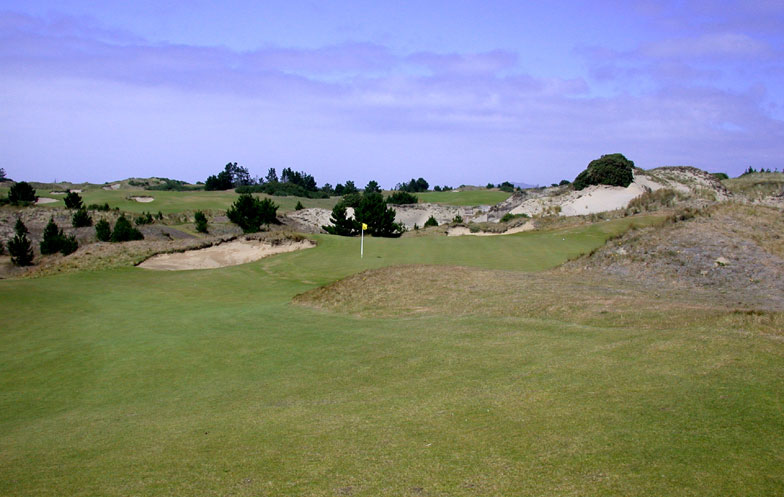
The slightly crowned green will shrug off-line approach shots.
2nd hole, 370 yards; The blown-out sand area to the right of the tee further sets the tone that this is a unique course. The 75 yard wide fairway is broken by a bunker in the left middle of the fairway at the 230 yard mark, exactly by the spot where you would like to drive to gain access into the left to right punchbowl green. Named the Shoe bunker, it is an example of a central hazard that is missing at Lost Dunes and it is also an example of how one of the locals pitched in to actually build the bunker. The ridge that fronts the green and helps create a punchbowl effect was always there.
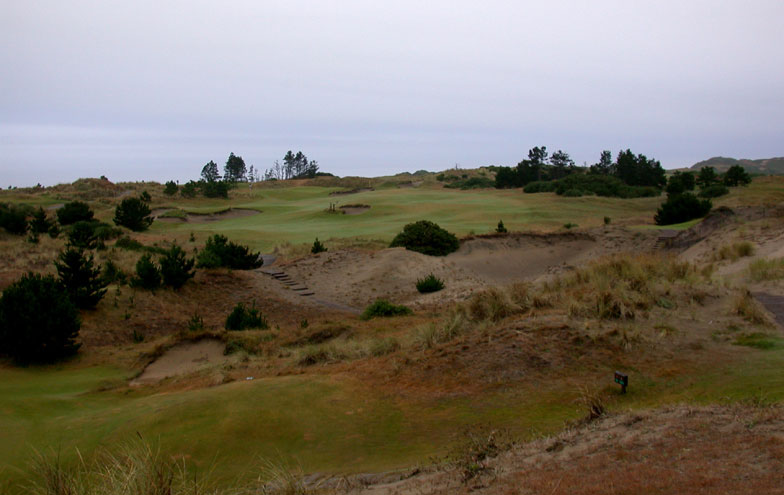
The bunker in the center of the fairway can distract the player from the larger one on the left.

Two bunkers were cut into a natural ridge that fronts the 2nd green. Coupled with the front left to back right angle of the green, the ideal approach shot is from the left half of the fairway.
3rd hole, 500 yards; A superb green complex for several reasons apart from the glorious views of the coastline that it affords. Its left to right orientation can dictate the playing strategy as far back as the tee. A forbidding right hand bunker guards half of this shelf green, which drops away on all sides. There are several back right hole locations that only a brave man (translation: fool) would chase. On one of the rare calm days, the use of such a hole location will give this hole plenty of teeth. The shared playing area with the 12th hole is something that even the mighty Sand Hills GC doesn’t enjoy.

The 3rd fairway heads for the cliffline. Depending on the hole location and wind, the golfer may want to drive left of the fairway bunker complex.
4th hole, 465 yards; Cliff top holes rarely produce drama equal to their spectacular location, unless some form of an angle is created as at 16 at Cypress Point or 8 at Pebble Beach or if the land has contour as at 11 at Ballybunion Old or 9 at Pebble Beach. In this case, the cliff top fairway is similarly flatto 7 at Ballybunion butDoakwas able to create an angle for the tee shot by perching the teeout ona finger of land and in so doing actually helped the player as it is now easier for him to play away from the cliff. The real work and art to the hole though lies around the green complex, which is ‘protected’ on the right by the 105 foot sheer drop to the beach below and a dune on the left. During the summer months when the hole plays downwind, the golfer who bails left with his tee ball will have an awkwardangle into the green. His approach must first carry the bunker15 yards short of the green but even then, the green enjoys a pronounced slope from left to rightto shrug off such approach shots. The golfer who stays closer to the cliffs off the tee will have an uninterrupted shot that he can land short and let chase on to the green. As a compliment to the field work that the Renaissance team did, few if any golfers will realize that the dune to the left was cut into so that the green could go where it presently sits: at fairway level with a glorious view down the coast line to the rocks near the Bandon harbour.

The 4th tee shot holds the golfer’s attention!

This bunker and the left to right slope of the green make any approach from the left a tricky one.
5th hole, 200 yards; This was the first hole built at Pacific Dunes and coupled with the 7th green, has the most interior contour. In terms of who built the course that oneactually plays, Doak’s long serving Design Associate Jim Urbina deserves the most credit and was on site for 165 (!)days. Combined with Renaissance’s Brian Slawnik, Bruce Hepner, Don Placek, Tom Mead,and Tony Russell as well asDave Wilber on turf, this talented crew jumpedon the project appreciating that it may be a once in a life time opportunity. One result is that the finishing work across the course is first rate.

An oasis in the dunes: the 5th green. A ball can land ten yards left of the hole and finish right of the hole.
6th hole, 320 yards; A unique holein worldgolf, thissleeper can dismantle the unthinking golfer. An innocuous 80 yard wide flat fairway greets the golfer and many a golferwill be delighted to seehis tee ball bounding along the fairway. At first that is, untilhe comes to his approach and finds that any tee ball to the left of center has to flirt with an 18 foot deep bunker that protects the elevated green. So what, you may say? You still have your trusty wedge in hand and can just drop the ball down on the green. In theory, perhaps, but the long green narrows to a mere 34 feet wide and a shaved bank runs down its entire right side. Thus, any approach from the left is frighteningly exact and with a little wind about, the golfer more than has his hands full. Conversely, if the golfer carries his drive 220 yards past the right hand fairway bunker, he is afforded a relatively straightforward pitch to one of the flatter greens on the course.

Ideally, the bunker on the right should be carried off the tee, thus taking the left pit out of play. The back of the 6th green is 11 paces wide and the bank to the right will see to it that a slightly off approach shot runs well away from the green.
7th hole, 465 yards; A perfect compliment to the short 6th with its flat green, this hole heads in the opposite direction and ends with one of the most contoured greens on the course. Though pine trees had to be cleared across the entire fairway, all the land forms around the greencomplex were there and Doak recognized early on the site’s potential. Such a stake helped with the rest of the course’s routing. Ala Royal Melbourne, the edges of the bunkers are tight to the putting surface.

The natural – and largely untouched – site that is now the 7th green complex.
8th hole, 400 yards; Doak’s encyclopedic knowledge of significant design features of the world’s finest courses must surely be an immense help in designing holes and this one is a case in point. Picturing the 3rd at Woking GC where a solitary green side bunker influencesevery approach angle, Doak saw the potential to create a similar play here. The back half of the greenis ina naturaldepression and Doak and Urbina hollowed out the area to the right of it and used that dirt to build the front part of the green. Approach shots can be thrown 10 yards to the right of the green, take the slope from the bowl and bound onto the green, all of this with the golfer neverneeding to flirt with the greenside bunker. The real genius, though, lies in how the central bunker distracts the player when playing to a left hole location from the real danger of the left bunker that is so close to the green that a player in it has precious little hope of getting the ball close to a left hole location. The slope at the front of the green makes the front-left hole location that much more difficult.
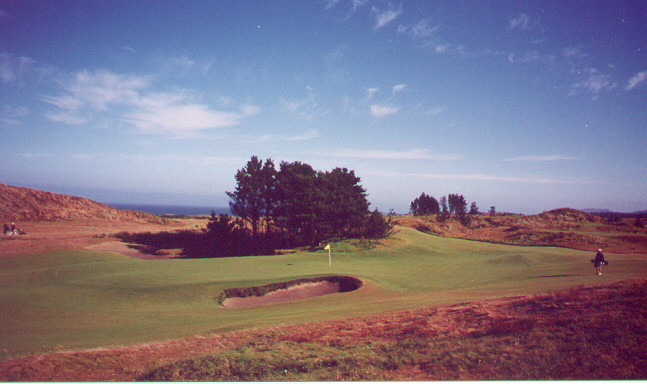
From this view short and right of the 8th green, the bowl of the rear portion of the green is evident. A player can land his approach where the golfer is and comfortably wind up on the green. Note also the slope at the front-left of the green.

A seemingly impossible hole location to which to get close.
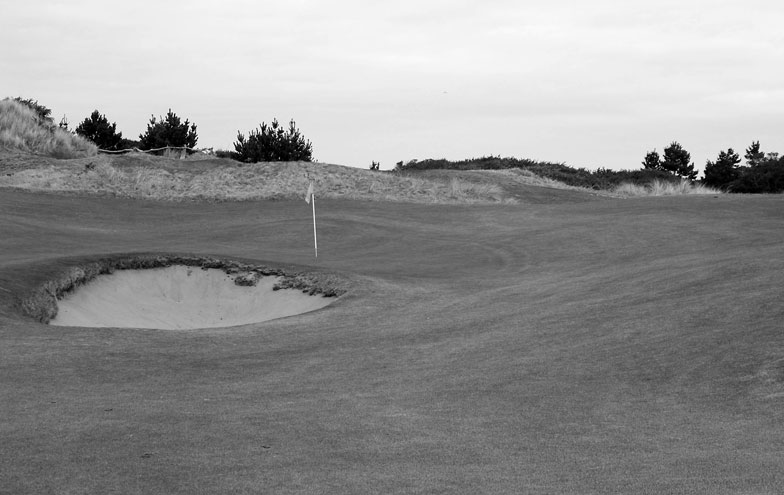
Closer inspection shows that the golfer can use the gathering nature of the terrain to the right of the green to feed the ball in tight.
9th hole, 405 yards & 10th holes, 205 yards; There is an upper and a lower green at the 9th and which green golfers prefer is a matter of debate. In part, which green is played at the 9th determines the tee used at the 10th: the lower green at the 9th leads to the lower tee at the 10th, which is a one shot hole of over 200 yards. The upper green at the 9th leds to the upper tee for the 10th, from where the hole is a postcard perfect drop shot one shotter of 135 yards to the green. The author is ambivalent as both combinations have merit, so it’s no wonder whyan alternate green was created.However, two points are worth mentioning that favor the lower 9th green/lower 10th tee combination, namely1) the downhill 9th green encourages the golfer to be as bold as possible in attackinga diagonal ridge off the tee – if successful, he has only a short iron left. The upper 9th green makes the hole play straightaway and thus robs this ridge of its strategic value, and 2) as played from the lower tee, the 10th becomes a long iron which adds to the variety of shots required on the second nine. Though rare, on calm days, the golfer is likely to have short irons into the 11th, 12th, 14th, 15th, 16th and 18th holes, so a long iron approach here at the 10th is a good thing.

The upper tee at the 10th provides this gorgeous view. As at the fallaway 12th green, there are no inspid little mounds to ‘frame’ behind the green.
11th hole, 150 yards; The second of two one shotters in a row, this hole is made by the threat of the beach 105 feet below and the rugged cross bunkers in front of the green. Thisone shotterhighlights threedifferences betweenBandon Dunes and Pacific Dunes: the green to tee walksare shorter at Pacific Dunes, the bunkering is more natural in appearance and length was less of a concern at Pacific Dunes. The bunkers that fronts the 11th greenare symbolic of the work: intricate fine-tuning was done to make the bunkers appear this natural.

12th holes, 530 yards; An interesting transition hole as it plays from one dune line across the flat 500 yard plain to a green at the base of the next set of dunes. This hole is made by the front bunker and ridgethat guard the left of the green, asking the golfer to come in from well to the right. The slope of the greenruns away from the golfer and falls towardthe back left. For this reason, though front hole locations at the 12th may appear simple, they are among the more vexing on the course as they send the frustrated golfer to the 13th tee without his up and down for thebirdie.

13th hole,445 yards; Picture the most dramatic hole at your home course. Now picture the 13th here: to the left, a 115 foot drop to the white beach below; to the right, a massive 60 foot exposed sand dune. In the summer, a fresh two club ‘breeze’ is in your face with the sound of the pounding surf everywhere. This then is the stage for your golf. Add in the fairway undulations and the false front to this deep green, and you have an untouched hole of great natural beauty that makes you itch to play golf. Thanks to the firm playing conditions obtained by Green Keeper Jeff Sutherland, many a ball rolls twenty yards down off the green’s false front and back into the fairway, an excellent design feature to have incorporated into the summer’s prevailing breeze.
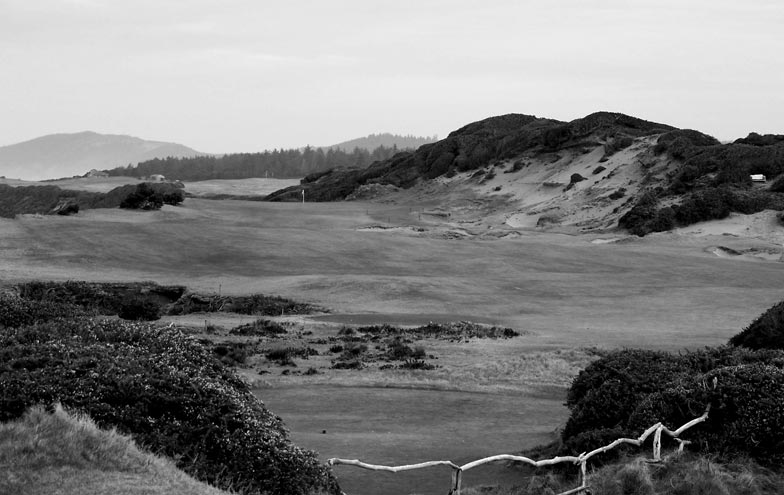



14th hole, 135 yards; Hitting from one dune across a valley to a green which was found by lopping off the top of another dune, this is an altogether clever hole with everything falling away from the plateau green. Any ball that fails to find its mark may well end upfifteen or more yards from the green.

The 14th plays along a ridge line with trouble (often severe) both right and left. This is the golfer’s last view of the ocean as the course turns inland for the final four holes.
15th, 540 yards; Along with the 12th, the 15th was the hole that always concerned Keiser as the golfer for the last time must cross the plain. Coupled with the fact that the golfer is leaving behind the ocean for good, no one wanted there to be any sense of a let down. There won’t be, as this hole offers that rare example of a hole that plays almost quite well whether downwind or into the wind. The green is loosely modeled after the Foxy Hole at Royal Dornoch. Downwind the golfer will need to squeeze his drive into a narrow neck to have a chance of reachingit in two and the sense of bounding along-iron up onto the plateau green makes for fine drama. Into the wind, the fairwayis an obstacle course as the player must negotiate a number of bunkers, the primary one of which is one smack in the middle of the fairway some 90 yards short of the green.

The view from the 15th tee shows the nest of bunkers 220 to 90 yards from the green with which the golfer hopes to get past in two. Tne last one at 90 yards from the green is in the middle of the fairway.
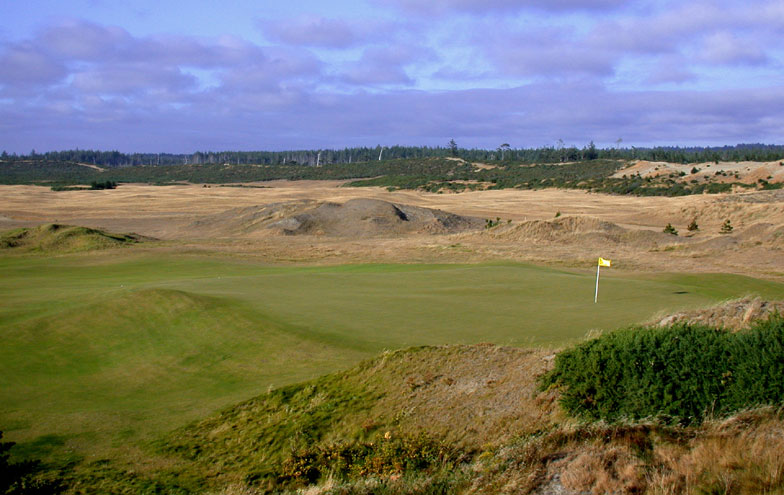
As this view from the 16th tee shows, there is no need for greenside bunkering on the 15th. The property for the fourth course (Old Macdonald) is in the distance.
16th hole, 340 yards; A favorite kind of hole, where the sight of the flag to the right lures the golferfurther in that direction than is wise. In fact, the idealplay into this angled green is from the far outside of the dogleg, atact that Renaissance also employed with great success at the 5th at Riverfront GC. In this case, the difficulty is compounded by one of the lumpiest fairways on the course and a short iron from an awkward stance is never a bargain. The green is on a natural shelf at the base of a sand dune and in a similar vien to the 6th, a birdie will prove far more elusive than the yardage indicates. With the wind from the north (behind and left to right), the player may also bash his drive near the green, taking his chances on getting a decent lie and stance in the hollow short and right of the green. From there, though, the 30-yard pitch is difficult enough to have players argue as to whether they would rather be 100 yards out in the fairway or 20 yards short of the green. The aspect of having appealing two shotters under 350 yards was foremost in Doak’s mind when he routed the course. Many of his favorite courses in the world – Crystal Downs, St. Andrews Old, Royal Melbourne West, Pine Valley – have such holes and Doak was determined for this to be the case at Pacific Dunes as well.

Finding a level stance is part of the challenge to approaching the 16th green.

The wonderful shelf green at the 16th, the angle of which suggests that approaches be played to it from the outside of the dogleg.
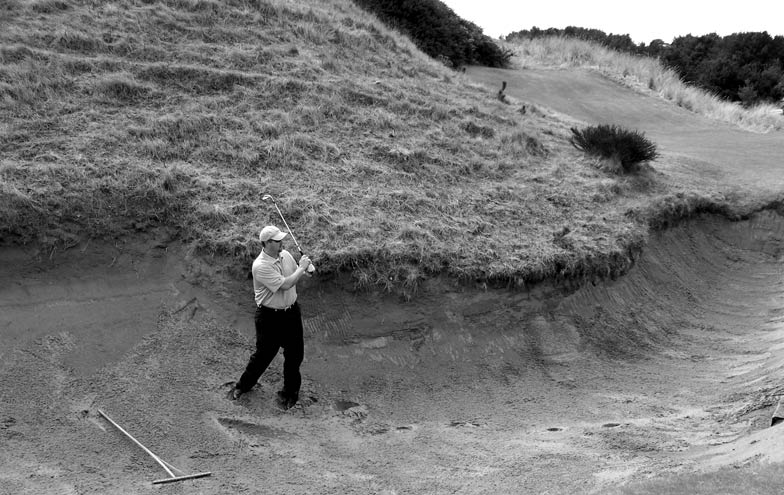
As the approach to the 16th is typically downwind, a ‘good’ pitch will often land short of the center of the green only to find this back bunker to the left of the green.
17th hole, 210 yards; Located in a sea of gorse, this one shotter is visually impressive. The four degree right to left slope in the 8,500 square foot green coupled with the ten foot deep left front bunker createmuch of aclassic Redan dilemma. Considering that the vast majority of modern courses that are built in windy environs put too much of a strain on the average golfer, Doak cleared a wide area to the right of the green so that the hole remains playable in even the summer winds. However, for those who like to see the screws tightened on the penultimate hole, some will lament the absence of the back right bunkering normally associated with a classic Redan.
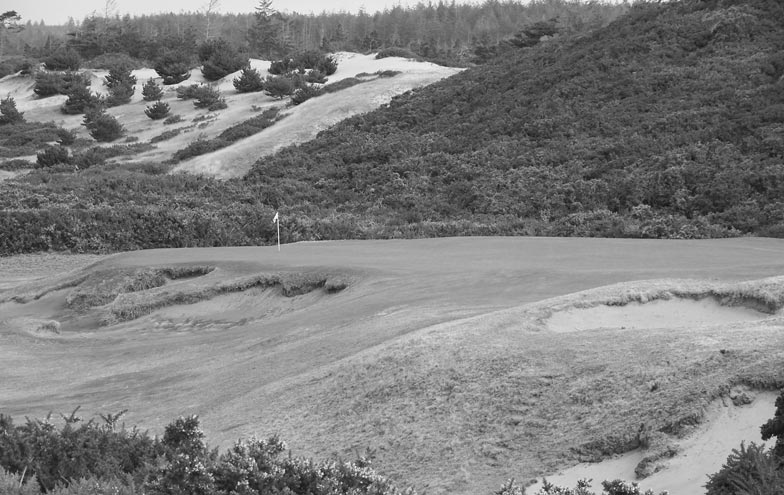
The dramatic 17th: the play is over the bunker in the foreground (which is 40 yards short of the green) and then let the right to left slope of the land do the rest of the work.
18th hole, 590 yards; Played through a valley between two dunes, Don Placek’s detailed bunkering work makes the hole. Of special interest is the unique green side bunker that visually appears as one with another one that is actually sixty yards away on the far hillside. Such artistry is rarely found in golf architecture today and comes when the architect has his best people on site for as long as possible.

Placek’s bunkering makes the 18th hole.
Having looked at the holes individually, one interesting aspect of the course is found in studying its routing: the lumpy, bumpy 1st and 2nd fairways which lead to the plain that the 3rd, 4th, and 6thth and 9th holes. The back nine enjoys the same change of pace: the par five 12th fairwayshares the same plain as the 3rd and 4thth with its heaving fairway. However, the 15thth and 18th. Such to-ing and fro-ing is nothing short of ideal. Doak used three of the three-shotters (3, 12, and 15) to chew up the plain. fairways are on before returning to the dune country for the 8 and leads the golfer into the dunes for the mighty 13 fairway returns again across the once gorse filled plain and leads to two of the lumpiest fairways on the course, the 16
Given that Pacific Dunes enjoys one of the thirty or so finest sites ever for a golf course, does the design equal the setting? Absolutely, as is partially evidenced by its world top twenty status by GOLF Magazine. In the past, the quality of some of Doak’s designshave been underminedby poor maintenance practices(e.g. Lost Dunes is consistently too wetwhile Apache Stronghold suffers from poor turf quality). Mercifully for Doak, hereon one of his greatest canvases, he was blessed with an excellent green keeping crew right from the start. Green Keepers Troy Russell and Ken Nice originally oversaw the grow-in andthegreen keepingfor its first several years.When Nice assumed responsibilities for the sister course Bandon Trails,Jeff Sutherland stepped in. The end resultis that these three men and their crew have achieved uniform fast and firm playing conditions throughout.The golfer has multiple options on how to play his approach shot into such greens as thesecond, fifth and eighth. Whether he elects to bank the ball off the short grass that surrounds these greens or play toward the middle ofthe greens in a more conventional manner, all options are available to him.In addition, the firm conditions allowPacific Dunestoprovide the raw challenge associated with the world’s finest links. If greens like the sixth and sixteenth were soft and holding,the course’srequirement for precise approach shotswould be diluted. Fortunately, such is not the case. The right men are in placeand thefast playing conditions throughout the courseare as good as any in the United States, allowing this design to reach its full potential.
Bill Coore made the most meaningful remark about Pacific Dunes when he said to a group of architects in March, 2001, ‘Pacific Dunes is the highest compliment to golf course architecture and it is what we should all strive for.’ Every student of architecture – as well as every golfer – needs to make the trip to see how special golf can be when the design equals its glorious setting.
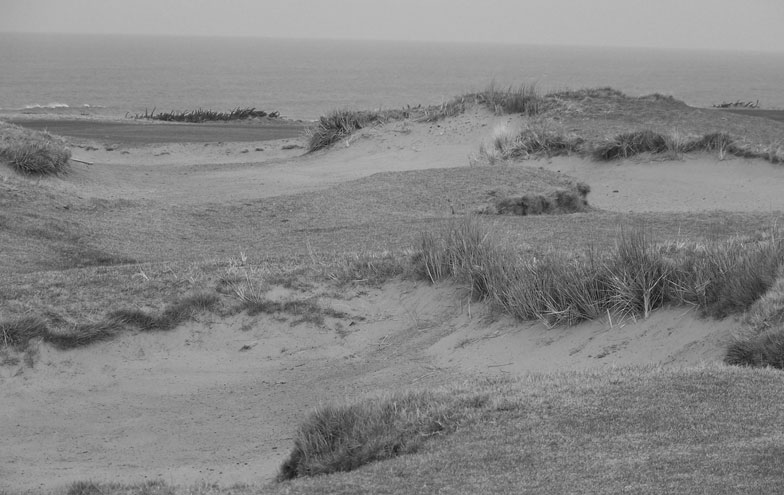
The craftmanship and strategy on offer at Pacific Dunes is the equal of its setting. This bunker complex is between the 4th and 12th fairways.
The End




![The Park, West Palm (Lit 9) [2023]](https://golfclubatlas.com/wp-content/uploads/2024/12/IMG_7092-2-scaled-500x383.jpg)



